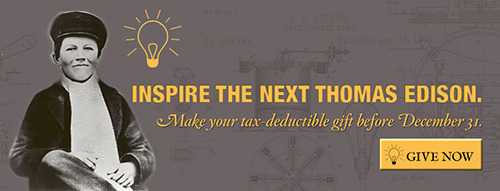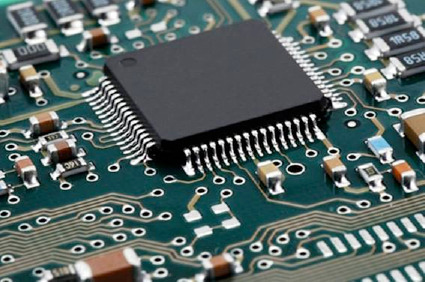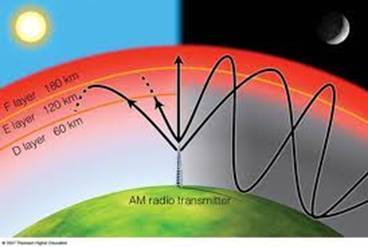Harry T. Roman's Blog, page 22
February 3, 2014
“Edison and the Rise of Innovation” – a Look Inside the Book – See Below for a Giveaway
“Edison” presents, in intimate detail, the man who helped engineer the modern world. One of history’s most prolific inventors, and perhaps America’s first celebrity, Thomas Alva Edison did more than bring incandescent light into every household and industry; he created a world-renowned brand, raised capital to support research and business, and pursued patents for his 1,000+ inventions.
[image error]
[image error]
[image error]
[image error]
[image error]
Leonard DeGraaf, archivist for the Thomas Edison National Historical Park, chronicles Edison’s life and work, making lively and lavish use of never-before-published primary sources, including Edison’s personal and business correspondence, lab notebooks, drawings, and advertising material, along with both historic and modern photographs.
ENTER and WIN
Enter to win one of two beautiful, hardcover, illustrated editions – each signed by the author, Leonard DeGraaf. Each book will also come packaged with Edison-themed lightbulb paperclips and a brief pocket biography.
Goodreads Book Giveaway
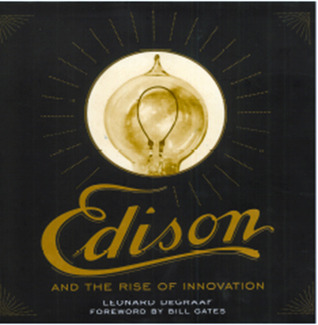
Edison and the Rise of Innovation
by Leonard DeGraaf
Giveaway ends February 10, 2014.
See the giveaway details
at Goodreads.
NOTE: This book can also be purchased at Barnes and Nobles or Amazon.
January 27, 2014
Hooray for Teachers – Nominate Your Favorite!
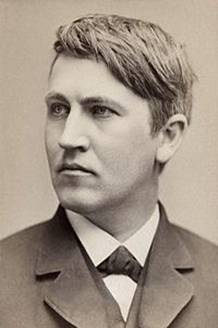 As we approach the birthday of Thomas Edison, February 11th, our thoughts turn toward the many teachers we have interacted with over the years, those who bring the Edison message and spirit to their students. Teachers are always communicating with us, asking questions, visiting the legendary West Orange labs, prowling our websites, encouraging student teams to take part in our annual Thomas Edison Invention Challenge, and developing lesson plans around the technological accomplishments of the world’s greatest inventor.
As we approach the birthday of Thomas Edison, February 11th, our thoughts turn toward the many teachers we have interacted with over the years, those who bring the Edison message and spirit to their students. Teachers are always communicating with us, asking questions, visiting the legendary West Orange labs, prowling our websites, encouraging student teams to take part in our annual Thomas Edison Invention Challenge, and developing lesson plans around the technological accomplishments of the world’s greatest inventor.
These teachers understand how to combine content and process in the curriculum, who have a magnificent comprehension of the importance of empowering their students to invent and dream of new things, just like the great inventor. In these heady days of STEM-style teaching in the classroom, and its importance to competing in a global economy, we celebrate the integration of science, technology, engineering and math. One cannot help but recognize that Thomas Edison, through his invention factory concept and the project management of perhaps 30-40 teams of inventors and craftspeople every day, pioneered the very taproots of STEM over 125 years ago.
Edison realized the value of education and often spoke out about the need to get the young ones to think and engage their creativity. One of the first uses he thought his invention of motion pictures would fulfill was for education in the classroom. Wow … sounds like a precursor to our online learning via the Internet! Here is something we always tell teachers about – Edison’s business philosophy:
Think out of the box
Be entrepreneurial-take risks
Fail your way to success
Success demands that you improve your products
We would like to recognize the special accomplishments of these Edison cheerleaders, those teachers who personify the Edison spirit and give their students an invaluable lifetime lesson. Take a moment and drop us a note about a teacher you know or work with who gives their students this kind of inspiration. You can send this to info@thomasedison.org. Maybe a simple email about this teacher and why you think they deserve to be recognized. We will do the rest.
Here are the cash prizes for the classroom:
First Place – $500
Second Place – $250
Third Place – $150
Good luck!
Sincerely,
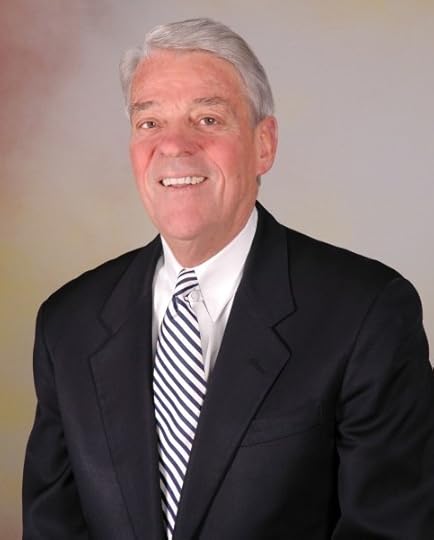
John P. Keegan
President and CEO
Edison Innovation Foundation
January 8, 2014
3D Printing Revolution – Body Parts Next
Thirty years ago a niche market, today poised for disruptive growth-3D printing is “the” hot topic. Pioneered in 1986 by 3D Systems Corp, this printing technology fuses successive layers of plastics and metals to build a structure based on Computer Aided Design (CAD) software. Each layer is about 0.1 mm thick, and consists of liquid, powder and sheet materials. It is currently used to make (print) prototypes/products in the automotive and aerospace fields.
The technology is now moving beyond industrial applications to the medical field, to produce hearing aids, dental restorations, artificial knees and hips; and prosthetic devices as well. Human tissue and organs are not far behind. Other application areas include food, power tools, toys, shoes, clothing and musical instruments.
GE, a big dog in the manufacturing world, plans to use 3D printing to make fuel nozzles for its new Leap jet engine-85,000 fuel nozzles to be exact, parts that will be lighter and more durable than traditionally made parts. GE plans to invest heavily in this technology, tripling the size of its 70-person 3D-printing staff, and expanding its factory floor fourfold. HP is one of several players in the burgeoning 3D printing market, and plans to introduce consumer-level printers in 2014. Rumor has it the new company prototype printer is a big fellow, five feet tall, maximizing speed and affordability.
Volume production is still a problem for 3D printing. It just takes time to build up all those layers of material, let alone complex composites. This is a big challenge for the would be leaders in this technology. Getting this right is important and could swing the “Made in China” mantra in the other direction-meaning jobs and economic growth on this side of the pond.
Could we someday soon be seeing small, local 3D printing shops springing up for folks to stop by and pick up their goods, supported by a local delivery service to bring them to you? Think of the gasoline energy that is saved every year because electronic letters via the electronic ether (Internet) have replaced paper and envelope letters previously delivered by snail mail. Experts estimate that even accounting for the energy used to make the electricity to send the email by traditional PC or smart phone, the electronic method of communicating is way more energy efficient, and of course much faster. Why wouldn’t we save energy similarly with sending manufacturing instructions electronically and printing the goods locally?
Yes, 3D printing is poised to be disruptive as it grows up and flexes its economic muscles. Who said manufacturing was dead?
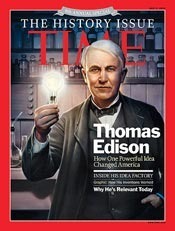 Thomas Edison says, “I find out what the world needs. Then I go ahead and try to invent it.”
Thomas Edison says, “I find out what the world needs. Then I go ahead and try to invent it.”Time ® is a registered trademark of Time Inc.
December 29, 2013
Donate Now!
Moore’s Law – Enabler for Disruptive Technologies
Ever wonder what drives all the disruptive technologies like smart phones, the cloud, the Internet, robots, and nano-technology?
It all started in the mid-1940s with the development of the transistor at Bell Labs, and after about 1970, the transistor thing went viral. There followed all sorts of very dense printed circuit boards and “chips” containing hundreds of thousands of transistors—allowing serious miniaturization of all things electronic/digital.
Telephones you can put in your pocket; computers you can easily carry around; smart appliances that can tell you they are not well; an Internet that runs 24/7/365 giving you unlimited shopping and worldwide communications; and now we are fusing the miniaturization of electronics and mechanical systems (mechatronics); when taken to the ultra-small we are creating nano-technology, a potentially unlimited way to change our material world.
All this happens because of Moore’s Law (circa 1965):
“The number of transistors incorporated in a chip will approximately double every 24 months.” – Gordon Moore, Intel co-founder
This folks is exponential growth, which experts believe will continue for another 20 years…maybe longer!
Ponder what this means to the increasing computational and processing capability you can squeeze into hand-held devices and how 4G speeds can easily become 5G or 6G in short order. But Moore’s Law does not relate to other technologies. Someone once opined if the kind of advances applying to electronics also applied to cars, we would have a vehicle that got 1,000 miles to the gallon and cost about one-tenth of what it does today…..but that is not likely to happen. However, cars have gotten very much safer and efficient because of Moore’s Law and integration of computers into them (about 30 microprocessors in each car today). The fruits of Moore’s Law have become an enabler of great change, i.e. disruptive technologies. One might say we are in an age of “Electronification” of our world, with uber-miniature computers and super-tiny machines all on a common slab of silicon … remind you of the “Borg” on Star Trek?
Who is responsible for starting this? About 133 years ago (1880) a fellow named Thomas Edison and his discovered Edison Effect, a phenomenon he stumbled across while trying to improve his light bulb filaments. Today we call his effect thermionic emission, where hot light bulb filaments spill out free electrons … electricity generated in a glass tube vacuum. Edison actually files the first electronic patent and uses his invention in his then budding electric utility system. Twenty plus years later, in the early 1900s, other inventors start using this discovery to create the first vacuum tubes-leading to radio; and forty years after that, transistors are born and put electronics on steroids. Now you know the whole story.
 Thomas Edison said … “To have a great idea, have a lot of them.”
Thomas Edison said … “To have a great idea, have a lot of them.”Time ® is a registered trademark of Time Inc.
December 23, 2013
Happy Holidays 2013
December 18, 2013
Thomas Edison Had a Tattoo!
Yeah baby … Thomas Edison had a tattoo, an image known as a quincunx-four dots arranged in a square, with a single dot in the middle. This image is the way the number five is portrayed on a dice cube. It was inscribed on his right forearm. The only catch is no one knows how the tattoo got there. There is no mention of it in the vast Edison archives. Did old Tom tattoo himself? We’ll never know.
According to the staff at the Thomas Edison National Historical Park [TENHP] Edison invented the electric pen in 1875 with the assistance of Charles Batchelor. The pen-like shaft had a reciprocating needle that was driven by a small motor powered by a wet-cell battery. As the user wrote or drew on a wax stencil, the needle made thousands of perforations per minute. The stencil was then placed in a press, and a roller forced ink through the holes, creating multiple copies (up to 15,000 according to Edison’s advertisements).
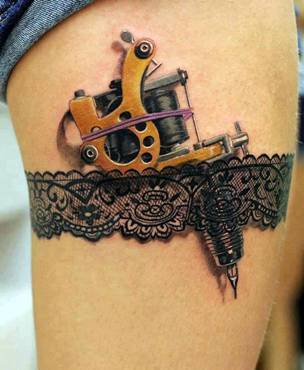
A tattoo of….an early tattoo pen!
The electric pen later evolved into the mimeograph and the tattoo needle. Today’s tattoo pens are much improved over the Edison electric pen, refined many times to deliver the beautiful tattoo designs that many folks desire, creating a genre of art known as “body art”. Humans have been decorating their skin for thousands of years-the tattoo pen merely facilitates this.
Three American president had tattoos. Teddy Roosevelt had a large family crest inscribed across his chest. James Polk had Chinese-character tattoos; and Andrew Jackson had an image of a tomahawk on his inner thigh. But wait … there’s more … Winston Churchill had an anchor on his forearm; and famed U.S. Senator Barry Goldwater of Arizona had a Native American symbol on his hand. So now you know the story about Edison and his tattoo, and those of other famous people.
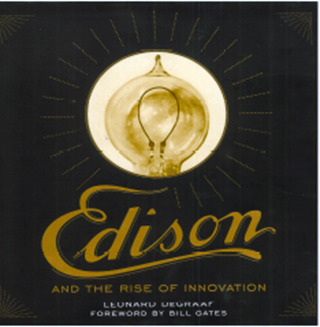 In the newly published Edison book, “Edison and the Rise of Innovation”, a detailed discussion of the tattoo pen is presented on page 16. This is a great book folks, packed with lots of photos and information about the great inventor. Over 15,000 copies have been sold thus far,with interest remaining keen. The book is available in Barnes & Noble book stores and on their web site at www.barnesandnoble.com. TENHP archivist Leonard Degraaf wrote this historic work. Bill Gates penned the foreword. We guarantee you will like this book; and yes, it makes for a wonderful gift to family and friends!
In the newly published Edison book, “Edison and the Rise of Innovation”, a detailed discussion of the tattoo pen is presented on page 16. This is a great book folks, packed with lots of photos and information about the great inventor. Over 15,000 copies have been sold thus far,with interest remaining keen. The book is available in Barnes & Noble book stores and on their web site at www.barnesandnoble.com. TENHP archivist Leonard Degraaf wrote this historic work. Bill Gates penned the foreword. We guarantee you will like this book; and yes, it makes for a wonderful gift to family and friends!
 Thomas Edison said … “I never perfected an invention that I did not think about in terms of the service it might give others… I find out what the world needs, then I proceed to invent …”
Thomas Edison said … “I never perfected an invention that I did not think about in terms of the service it might give others… I find out what the world needs, then I proceed to invent …”Time ® is a registered trademark of Time Inc.
November 19, 2013
Thomas Edison: The Emergence of R&D
 “Edison and the Rise of Innovation” is a newly released book from Sterling Publishing. This article borrows from the book, and discusses a key aspect of Edison’s West Orange Labs-R&D as a powerful force for economic growth. The book is available in Barnes & Noble book stores and on their web site at www.barnesandnoble.com. Bill Gates wrote the foreword to this delightful book.
“Edison and the Rise of Innovation” is a newly released book from Sterling Publishing. This article borrows from the book, and discusses a key aspect of Edison’s West Orange Labs-R&D as a powerful force for economic growth. The book is available in Barnes & Noble book stores and on their web site at www.barnesandnoble.com. Bill Gates wrote the foreword to this delightful book.
—-
As Thomas Edison builds what will become his legendary West Orange Labs (1887), his dream to combine invention and entrepreneurship takes hold. At West Orange, Edison takes his R&D project team concept from Menlo Park, feeds and nourishes it with vitamins, gives it a strong market thrust, and basically transforms R&D from a cottage industry to an industrial powerhouse.
Edison establishes a complex of manufacturing enterprises (about 30 companies, known as Thomas A. Edison Industries) to complement his invention factory, employing over 10,000 people on 23 acres of land. His invention factory employs about 250 experts, technicians, engineers and craftsmen who develop new ideas for the rest of the employees to make and sell. The leverage of R&D to manufacturing is great–for every R&D person employed, Edison realizes 40 manufacturing jobs.
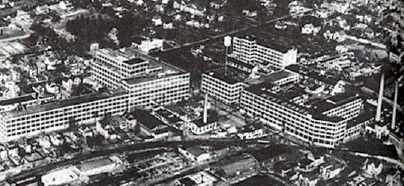
The West Orange Labs complex-home to 10,000+ employees (ca. 1910)
So important is this commercialization of R&D, that between 1895 and 1926 (within Edison’s lifetime) many of the country’s great corporate R&D labs are established-true testimony to the power of commercial R&D. Today, the U.S. spends close to $440 billion a year on R&D in all sectors of the economy, a total greater than the annual revenue of any of America’s largest corporations.
At West Orange, America sets its feet upon the path of technology driven economic growth, our modern conception of progress is forged. Many industrialists come to the site to tour and learn. Edison the entrepreneur is experimenting with streamlining his vertically integrated manufacturing, critical path analysis for improved project management, and better ways to educate employees about building complex products. Henry Ford, an Edison devotee and life-long friend, is watching and learning; and from 1917-1928 he builds his own vertically integrated, mega-monument to economic growth, his famous River Rouge automobile factory, churning out automobiles by the millions.
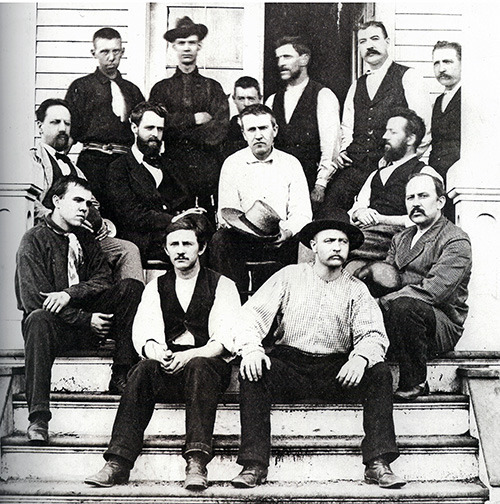
Thomas Alva Edison and his close team members
Today, 82 years after his death, Thomas Edison’s accomplishments, processes, and industries established account for about 10% of the U.S. economy. His work, according to the Voice of America is responsible for one-fourth of all the jobs on the planet. West Orange is the harbinger of what would later become the second great wave of commercial R&D, Silicon Valley.
And one more important note. All this cool stuff you hear going on in schools today … STEM … Science, Technology, Engineering, and Math … that is exactly what Edison and his “Muckers” did at West Orange, all day long. Schools are re-discovering Mr. Edison; and a whole new generation of inventors is being inspired. Thanks Tom!
 Thomas Edison said … “The man who doesn’t make up his mind to cultivate the habit of thinking misses the greatest pleasure in life.”
Thomas Edison said … “The man who doesn’t make up his mind to cultivate the habit of thinking misses the greatest pleasure in life.”Time ® is a registered trademark of Time Inc.
November 12, 2013
Setting the Tone for an Innovative School Year
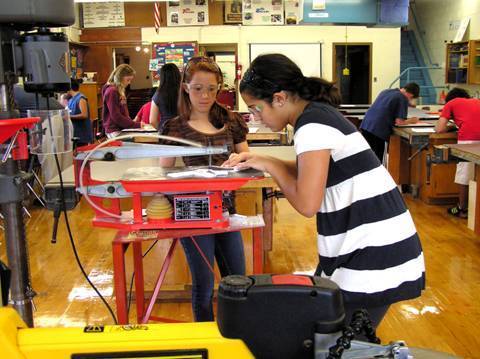 Many teachers, including myself take the summertime to relax, recharge and reflect on what is working in their classrooms, and what needs to be modified and updated. A laundry list of modifications and good intentions continues to develop as the first days of school draw near. Too often, the ambitious list of improvements gives way to the reality of preparing a classroom, in-service days, seating charts, attendance and grading policies.
Many teachers, including myself take the summertime to relax, recharge and reflect on what is working in their classrooms, and what needs to be modified and updated. A laundry list of modifications and good intentions continues to develop as the first days of school draw near. Too often, the ambitious list of improvements gives way to the reality of preparing a classroom, in-service days, seating charts, attendance and grading policies.
Teachers must make it clear to our students that in order to become truly innovative in the classroom, they will need to take risks and be prepared to fail. As teachers, we too often place such emphasis on getting the correct answer the first time, that we fail to remember that it was Thomas Edison who said, “I have not failed, I have just found 10,000 ways that won’t work.” Students need our support and guidance, while they experience failure along the road to success. Students are conditioned from an early age to play it safe, and go for the sure thing that will satisfy the problem the teacher has presented. What we do not do often enough, is leave problems open ended and encourage the ideation and creativity that can only exist when the risk of punitive failure is removed.
A method I use in my technology education classroom is allowing students to document their work thoroughly throughout the process. They document research, design idea, the build process, and the results of the testing of their product. Following this, they evaluate what they would change, and why. This authentic learning allows students not only the ability to take a risk, but justify their reasoning, and evaluate and synthesize decisions made. Overall, this is a very powerful learning experience.
 So keep it innovative, but keep it structured. Allow for freedom of design, but insist on justification and reflection. Allow your students the opportunity to experiment, invent, and create in an environment that truly encourages innovation.
So keep it innovative, but keep it structured. Allow for freedom of design, but insist on justification and reflection. Allow your students the opportunity to experiment, invent, and create in an environment that truly encourages innovation.
Kenny Zushma
Teacher of Technology Education
Heritage Middle School
Livingston, NJ 07039

Thomas Edison said … “The man who doesn’t make up his mind to cultivate the habit of thinking misses the greatest pleasure in life.
Time ® is a registered trademark of Time Inc.
November 1, 2013
Radio Waves – Answer to Climate Change?
The upper atmosphere, specifically Earth’s ionosphere may hold the answer to proving our climate is warming. The ionosphere is used for radio and other long wave communications. Researchers at Tel Aviv University have been studying the dynamics of radio waves reflecting off the ionosphere. The strength of reflected signals can indicate changes in the temperature of the upper atmosphere. Their research shows weaker radio signals bouncing back to Earth would indicate cooler temperatures in the upper atmosphere; and hence global warming down here where we humans live.
Did you know?
The ionosphere is a shell of electrons and electrically charged atoms and molecules that surrounds the Earth, stretching from a height of about 50 km (31 mi) to more than 1,000 km (620 mi). It owes its existence primarily to ultraviolet radiation from the Sun. [source: Wikipedia]
The presence of greenhouse gases in the upper atmosphere would be responsible for the absorption of radio wave signal strength, acting like a giant blanket around the Earth; and this keeps heat from escaping into space-hence the so-called greenhouse effect in the lower atmosphere. As the upper atmosphere gets colder, reflected radio signals lose their strength.
Tel Aviv researchers compared temperatures in the upper atmosphere [satellite collected data] with that collected and interpreted on the ground via reflected radio waves. A clear correlation, consistent over time was obtained. It is getting cooler in the upper atmosphere and that means warmer down here on “terra firma”.
Work done on this important research project will help scientists understand just how much the sun affects temperature changes in Earth’s atmosphere, versus how much man is impacting it. This effort could give a much more complete picture of what is happening in the upper atmosphere, which may also provide a better understanding of the impact of solar storms and thunderstorms on this high altitude region.
Did you know?
Edison’s discovery of what he called the Etheric Force [detection of electromagnetic waves propagated through air] later became the basis for wireless and soon thereafter radio. His discovery of the Edison Effect [the emission of electrons via heated light bulb filaments] led directly to the development by others of vacuum tubes, making modern radio possible. Edison is the taproot for modern day telecommunications.
Editor’s Deep Dive
http://www.swpc.noaa.gov/info/Iono.pdf
http://www.sciencedaily.com/releases/2013/07/130730123421.htm
http://science1.nasa.gov/science-news/science-at-nasa/2008/30apr_4dionosphere/
 Thomas Edison said … “There are no rules here, we’re just trying to accomplish something”
Thomas Edison said … “There are no rules here, we’re just trying to accomplish something”Time ® is a registered trademark of Time Inc.
Harry T. Roman's Blog
- Harry T. Roman's profile
- 2 followers




